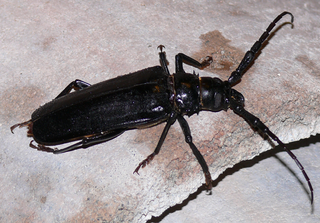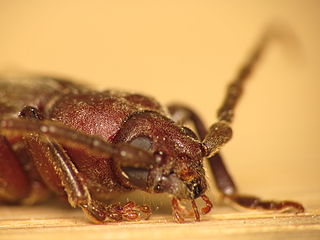
The longhorn beetles (Cerambycidae), also known as long-horned or longicorns, are a large family of beetles, with over 35,000 species described. Most species are characterized by extremely long antennae, which are often as long as or longer than the beetle's body. In various members of the family, however, the antennae are quite short and such species can be difficult to distinguish from related beetle families such as the Chrysomelidae. The scientific name of this beetle family goes back to a figure from Greek mythology: after an argument with nymphs, the shepherd Cerambus was transformed into a large beetle with horns.

Derobrachus is a genus of beetles in the Cerambycidae. It contains the following species:

Arhopalus is a genus of beetles in the family Cerambycidae, the longhorn beetles, in the tribe Asemini.

Tyrpophloeus is a genus of bark beetles. About 12 species comprise the genus, ranging from North America to Europe and Asia. The genus is little-known, but T. populi has recently become important as the causative agent of sudden aspen decline.
Xorides ater is a parasitoid wasp from ichneumonid family that parasitizes long-horned beetles of next species and subspecies: Tetropium castaneum, Arhopalus rusticus rusticus.

Xorides fuligator is a parasitoid wasp from Ichneumonid family that parasitizes long-horned beetle of subspecies Arhopalus rusticus rusticus.

Leptostylus is a genus of longhorn beetles of the subfamily Lamiinae. It was described by John Lawrence LeConte in 1852.

Asemini is a tribe of beetles in the subfamily Spondylidinae, containing the following genera and species:

Leptostylus asperatus is a species of longhorn beetles of the subfamily Lamiinae. It was described by Haldeman in 1847.
Caribbomerus is a genus of beetles in the family Cerambycidae, containing the following species:

Derobrachus asperatus is a species of beetle in the family Cerambycidae. It was described by Bates in 1878.
Arhopalus cubensis is a species of beetle in the family Cerambycidae. It was described by Mutchler in 1914.
Arhopalus productus is a species of beetle in the family Cerambycidae. It was described by John Lawrence LeConte in 1850.

Arhopalus rusticus is a species of beetle in the family Cerambycidae. It was described by Carl Linnaeus in his 1758 10th edition of Systema Naturae.

Zographus oculator, the Orange-eyed Long-horn Beetle, is a species of flat-faced longhorn beetles belonging to the family Cerambycidae.
Caribbomerus asperatus is a species of beetle in the family Cerambycidae. It was described by Fisher in 1932.
Trachyphloeus asperatus is a species of broad-nosed weevil in the beetle family Curculionidae. It is found in North America.

Sciaphilus is a genus of beetles belonging to the family Curculionidae.
Ambrosiodmus asperatus, commonly known as ambrosia beetle, is a species of weevil found in China, India, Nepal, Indonesia: Java, Sumatra, Japan: Ryukyu Islands, Malaysia, Sri Lanka, Taiwan, and Brunei. The species also introduced to Australia.










